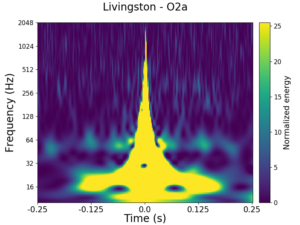As gravitational wave scientists prepared to turn their detectors back on in mid-May, the Gravity Spy Citizen Science team expanded the scope of their project to further refine the data generated by LIGO‘s detectors. This past winter, CIERA had the privilege of hosting the first meetings of “Gravity Spy 2.0” on February 3-4 and 27-28, 2023.
Gravity Spy is a National Science foundation-Funded interdisciplinary project that combines citizen science, machine learning, social science, and gravitational wave detection technology. “The detection of gravitational waves has opened a new and exciting window to study astronomical phenomena which were previously inaccessible,” explains CIERA Postdoctoral Associate Dr. Sharan Banagiri, who has been highly involved in Gravity Spy.
“The LIGO detectors are instrumental behemoths, with many subsystems, control loops, and suspensions. As with any complicated system, sometimes, there is unintended behavior that produces instrumental noise artifacts that can hinder our ability. Particularly pernicious are glitches; fleeting but loud noise artifacts arising from a variety of sources. Glitches come in different shapes and sizes, giving rise to a veritable ‘zoo’. Understanding the glitch types and categories can help our scientists learn about their sources, and, hopefully, mitigate or even eliminate them. Using the Zooniverse platform, the Gravity Spy project enables us to engage with interested ‘citizen science’ volunteers who classify these glitches and help us better understand them. Over the years, Gravity Spy has become a crucial initiative for our efforts to better understand the behavior of the LIGO detectors.”
Speaking to the shift to Gravity Spy 2.0, Banagiri continued, “We are now excited to be working on the second iteration of Gravity Spy, where the ‘citizen science’ volunteers will look at glitches not just in gravitational wave data, but in a variety of auxiliary channels. These channels record the environmental conditions or the states of the different instrumental systems in LIGO. Studying commonalities between the glitches in these channels with the glitches in the gravitational wave data can help better understand the source and origins of these glitches.”

A “glitch” detected in gravitational wave data
Dr. Mike Zevin, current NASA Hubble Fellow at the University of Chicago, helped build and design the interface of Gravity Spy on the Zooniverse platform during his graduate studies at Northwestern (PhD ’20). Alongside fellow graduate student Scott Coughlin and the rest of the CIERA Gravity Spy team, they interfaced with project volunteers and implemented the machine learning algorithm that classifies glitches in gravitational wave detection data.
“This project has not only led to important scientific progress, but also has become a medium for interested volunteers around the world to become engulfed and excited by scientific progress,” said Zevin. “I was amazed by the enthusiasm and participation of our tens of thousands of volunteers. Some of the volunteers on the project truly became experts in the field, and at this point are a crucial aspect in keeping the project running. On the citizen science end of things, Gravity Spy has really pushed the envelope on some of the capabilities of volunteer-based projects, both in its training regimen and in the symbiosis of human classification and machine learning schemes. It was fantastic to see all of the Gravity Spy team in February, some of which I have been collaborating with for almost 8 years. I’m excited to see the new rendition of Gravity Spy making significant progress.”
The fourth gravitational wave observing run, O4, is scheduled to begin on May 24, 2023 and continue for a year and a half. As such, new glitches will be rolling in soon and the Gravity Spy team will be hard at work collaborating with the public to categorize them, improve the algorithms that search for them, and contribute to the impact of gravitational wave research worldwide.
“Citizen science projects give us the chance to directly engage with the public and work with them in the process of doing science”, said Dr. Banagiri. “This teamwork makes the Gravity Spy project crucial in understanding the noise transients in the detectors and detecting more gravitational-wave signals. It is inspiring to see how dedicated some volunteers are about Gravity Spy and understanding glitches. As a publicly-funded scientist, I strongly believe it is important that society at large gets back not just the technological returns from scientific investments, but also the chance to appreciate the more aesthetic fulfillment that comes from doing science.”

